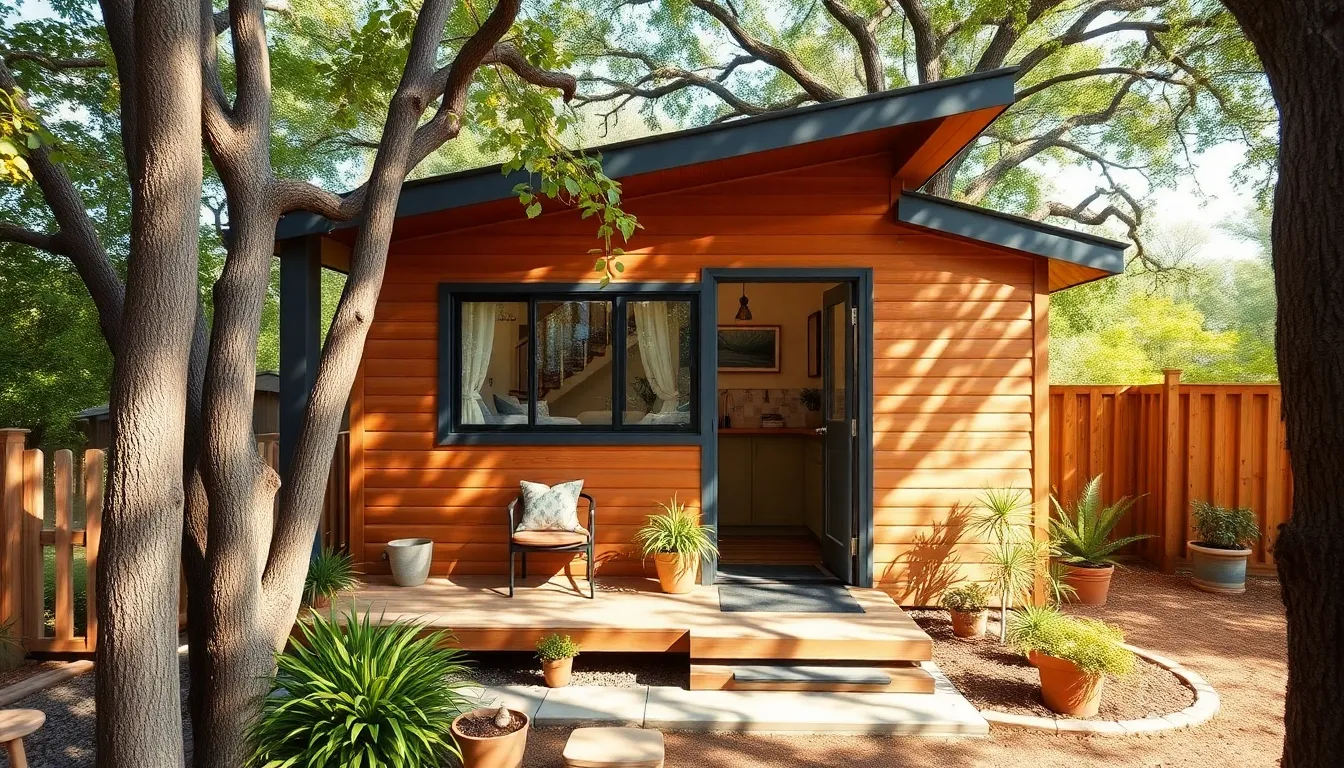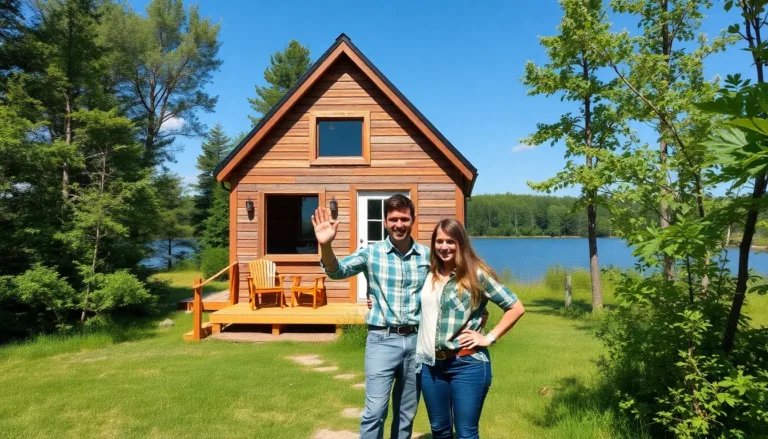Table of Contents
ToggleIn the heart of Texas, where everything’s bigger, a quirky trend is taking root: tiny homes. Imagine living in a cozy space that’s just as charming as it is efficient. In Austin, these pint-sized dwellings are popping up like wildflowers, offering a unique blend of sustainability and style. Who knew downsizing could be this much fun?
Tiny homes in Austin aren’t just about cutting costs; they’re a lifestyle choice for those craving simplicity and connection with nature. With the city’s vibrant culture and stunning landscapes, living small can lead to big adventures. So, if you’re ready to trade in your sprawling mansion for a minimalist haven, buckle up! Tiny living might just be the ticket to a happier, more fulfilling life in the capital of Texas.
Overview of Tiny Homes in Austin
Tiny homes in Austin offer a unique blend of functionality and aesthetics. These dwellings maximize space and reduce environmental impact while promoting minimalist living. Residents appreciate lower utility costs, which often stem from reduced square footage. In partnership with local organizations, builders create innovative tiny home communities that foster a sense of belonging.
Tiny home designs vary, incorporating multiple styles such as modern, rustic, and industrial. Each design emphasizes sustainable materials and energy-efficient technologies. The interest in tiny homes correlates with a broader movement towards eco-friendly living and urban sustainability. Local regulations increasingly support this trend, allowing for creative zoning practices and flexible building codes.
Individuals pursuing tiny homes often seek proximity to Austin’s vibrant cultural scene. Access to parks, food trucks, and live music enhances the appeal of these compact residences. Community events centered around tiny living encourage networking and sharing ideas among residents.
Investors recognize the potential for rental income in the tiny home market, which attracts both locals and visitors. On average, a tiny home in Austin costs between $30,000 and $150,000, depending on features and location. The city’s diverse neighborhoods accommodate various tiny home types, from standalone units to those within micro-communities, creating options for various lifestyles.
Overall, tiny homes in Austin represent a practical solution to urban housing challenges. They support both personal lifestyles and community development, offering a glimpse into sustainable living in a bustling city.
Benefits of Living in Tiny Homes

Tiny homes offer numerous advantages for residents in Austin. These dwellings provide significant benefits in financial savings and lifestyle changes.
Financial Savings
Living in a tiny home reduces monthly expenses substantially. Utility bills drop due to smaller space requirements. Property taxes often decrease, leading to overall lower housing costs. Many tiny homes range from $30,000 to $150,000, making them affordable options for buyers. Maintenance is less demanding, too, allowing for further savings over time. This financial relief often encourages residents to allocate resources toward experiences, travel, or investments. Tiny living promotes financial freedom, appealing to individuals looking for a fresh start in Austin.
Minimalist Lifestyle
A minimalist lifestyle thrives in tiny homes, emphasizing experiences over possessions. Space constraints lead residents to prioritize essential belongings, fostering intentional living. This approach eliminates clutter and encourages thoughtful consumption. Connecting with nature becomes easier, as outdoor living areas often complement tiny homes. Many residents report enhanced well-being and reduced stress levels through this simplified lifestyle. Community engagement grows as residents share their journeys toward minimalism, promoting a supportive environment. Choosing tiny living encourages individuals to appreciate life’s simple pleasures while living harmoniously in Austin’s vibrant community.
Popular Tiny Home Communities in Austin
Austin boasts several vibrant tiny home communities that embody the principles of sustainability and minimalism. Each community offers unique features that appeal to a range of lifestyles.
Community Features
Innovative designs and eco-friendly living highlight the community features. Shared amenities often include community gardens, outdoor gathering spaces, and recreational areas. Residents cherish the opportunity to connect with neighbors through organized events and activities. Communication within the community promotes relationships among tiny home dwellers. Access to local parks and trails provides additional enjoyment for those who appreciate the outdoors. Energy-efficient appliances and sustainable building materials enhance the overall living experience.
Notable Developments
Several notable developments shape the tiny home landscape in Austin. One prominent community, Community First! Village, emphasizes providing affordable housing for the previously homeless. Nestled within a 27-acre property, it offers social services, support systems, and a heartfelt sense of belonging. Tiny homes at the habitation project range from $30,000 to $40,000. Additionally, the Kohler Tiny House Community features meticulously crafted homes with modern amenities, appealing to those looking for style and functionality. Rentals within this community often attract tourists seeking a unique Austin experience. Each development contributes to the growing awareness of tiny living and its benefits.
Regulations and Zoning for Tiny Homes
Tiny homes in Austin face specific regulations and zoning requirements to ensure they fit within the urban landscape. Understanding these rules helps residents navigate the tiny living experience efficiently.
Building Codes
Building codes in Austin vary based on the tiny home’s structure, size, and location. Compliance with safety standards, fire regulations, and accessibility requirements is essential. Structures under 400 square feet often qualify as accessory dwelling units (ADUs), allowing creative freedom in design while adhering to municipal guidelines. The city mandates that tiny homes meet foundational stability, plumbing, and electrical codes to ensure durability. Residents must consult the Austin Building Department for precise standards, fostering a secure living environment.
Permitting Process
The permitting process for tiny homes involves several steps to achieve legal status. Owners must submit an application detailing the home’s design and proposed location. Zoning reviews consider the property’s compatibility with existing land uses and neighborhood plans. Typically, the average processing time takes about 30 to 60 days. Upon approval, builders receive permits that authorize construction or modification. City officials often hold community meetings to address concerns, promoting transparency and neighborly collaboration. Understanding this process prepares homeowners for a smoother transition into tiny living.
Tiny homes in Austin are more than just a trend; they represent a shift towards sustainable living and community engagement. As residents embrace this lifestyle, they discover the joys of minimalism and financial freedom. The unique designs and innovative communities enhance the overall experience of living in this vibrant city.
With a focus on eco-friendly practices and intentional living, tiny homes cater to those seeking a deeper connection to their surroundings. As Austin continues to evolve, the tiny home movement will undoubtedly play a significant role in shaping the future of urban living. This growing community not only addresses housing challenges but also enriches the lives of those who choose to call these compact spaces home.







